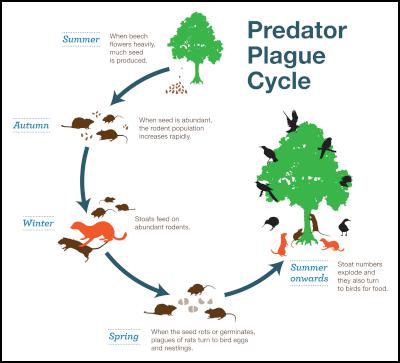DOC to protect species at risk from predator plague
Media release
29/1/14
Embargoed until 8 pm
DOC to protect species at risk from predator plague
The Department of Conservation is preparing a major new pest control campaign to protect vulnerable native species from an expected surge in rat and stoat numbers later this year.
Climatic conditions have prompted an unusually heavy forest flowering this summer across both islands. The flowering is particularly prominent in South Island beech trees.
DOC scientists predict the bumper seed fall resulting from this “masting” event will fuel rapid increases in rat and stoat numbers putting vulnerable populations of rare birds, bats and other species like threatened snails at high risk in the coming spring.
Director-General Lou Sanson says DOC has identified South Island forest sites with high risk populations and will be closely monitoring these areas in coming months for early signs of rapidly rising predator numbers.
He says similar conditions fourteen years ago drove rat and stoat levels to plague proportions and decimated South Island populations of rare species such as mōhua/yellowhead and kākāriki karanga/orange fronted parakeet.
“If predator trigger levels are reached again this year, we are ready to significantly extend our South Island aerial and ground-based protection operations as part of a “Battle for our Birds” campaign.
Lou Sanson says DOC teams are targeting extra protection this year for both mōhua and kākāriki along with at risk populations of kiwi, whio/blue duck, kea, kaka, rock wren, giant land snails and native bats.
“Field staff will be closely watching the seed fall and rat tracking results from these key sites over the next few months.”
“We need to be ready to act quickly to knock back rat or stoat numbers before they overwhelm birds which are particularly vulnerable during the spring nesting season.”
Lou Sanson says DOC will be prepared to provide additional aerial 1080 protection over about half a million extra hectares of public conservation land in the South Island.
“We’re concerned that our existing trap and ground based networks will get overwhelmed if predator numbers rise rapidly. Our best, and fastest, option for protection over large tracts of rugged bush is using biodegradable 1080 baits by air.”
Lou Sanson says DOC will also be supporting this year’s planned “beech mast” response by increasing its maintenance level of aerial 1080 operations over five years.
“Pest control is relentless – we may not be able to eliminate the threat but we can increase the level of protection we provide.”
“Without protection, for example, kiwi are expected to disappear from the wild within two human generations — we need to act to give our native species a fighting chance.”
Maps detailing the vulnerable species to be protected and sites identified for potential aerial 1080 operations for 2014/15 along with a simple graphic illustrating the impacts of a beech mast are available at www.doc.govt.nz/battleforourbirds

Click for big version.
A short video
explaining the impact of a beech cycle on predators and
native species is also available at: http://youtu.be/fpwl36QUq60
For
further information contact Rory Newsam 04 4713104 or 027
295 3809
Background:
• DOC manages
about 8.7 million hectares of public conservation land.
• The biodegradable poison 1080 is currently
applied by air by DOC and TBfree NZ to control possums, rats
and stoats on a total of about 440 000 hectares of public
conservation land. This represents about 5 percent of all
public conservation land.
• If required,
DOC’s aerial 1080 response to this year’s South Island
beech mast threat would increase by about 500 000 hectares
and this together with TBfree NZ’s planned programme would
result in a total of about a million hectares of public
conservation land being treated with aerial 1080 in 2014/15.
This represents about 12 percent of all public conservation
land.
ENDS


 Gordon Campbell: On bird flu, AUKUS entry fees and Cindy Lee
Gordon Campbell: On bird flu, AUKUS entry fees and Cindy Lee NZ Government: New Lab To Help Protect Key Pacific Tuna Fisheries
NZ Government: New Lab To Help Protect Key Pacific Tuna Fisheries Susan Botting - Local Democracy Reporter: Ruawai Leader Slams Kaipara Council In Battle Over $400k Property
Susan Botting - Local Democracy Reporter: Ruawai Leader Slams Kaipara Council In Battle Over $400k Property Te Pati Maori: Another ‘Stolen Generation’ Enabled By Court Ruling On Waitangi Tribunal Summons
Te Pati Maori: Another ‘Stolen Generation’ Enabled By Court Ruling On Waitangi Tribunal Summons Peace Action Wellington: Die In for Palestine Marks ANZAC day
Peace Action Wellington: Die In for Palestine Marks ANZAC day Labour Party: Penny Drops – But What About Seymour And Peters?
Labour Party: Penny Drops – But What About Seymour And Peters? Government: PM Announces Changes To Portfolios
Government: PM Announces Changes To Portfolios


